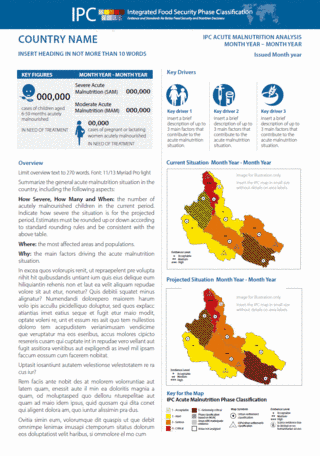IPC Acute Malnutrition (AMN) Country Report

Type and Objective of Product
Technical Analysis Product
The IPC Country Acute Malnutrition (AMN) Report is a comprehensive technical document that presents detailed findings from an IPC acute malnutrition analysis. It is the definitive source for understanding acute malnutrition’s scope, severity, and contributing factors in a specific country or region.
Ownership
The IPC Country AMN Report is developed collaboratively by the IPC Technical Working Group (TWG) of the country in focus, with support and oversight from the IPC Global Support Unit (GSU). The technical Working Groups retain final ownership.
Mandatory Content
Each AMN Report includes the following key components:
- Overview: High-level overview of key findings of the current and projection analysis.
- Contributing Factors: Analysis of the factors contributing to the nutrition crisis.
- IPC AMN Findings:
- Overview: A detailed summary of the current and projected malnutrition situation, complemented by visual representations such as key figures and maps.
- Caseload table: A comprehensive table capturing key demographic data, including children under 59 Months and pregnant and breastfeeding Women.
- Recommended Actions: Actionable steps for AMN response and mitigation.
- Methodology: Overview of the IPC process and data sources used.
- Annexes: Technical data, maps, and references.
Target Audience
The AMN Report is designed to meet the needs of a diverse range of technical audiences, including:
- Humanitarian Agencies (Primary): UN agencies, NGOs, and donors involved in planning and implementing interventions.
- Donors (Primary): International donors provide critical funding and resources for humanitarian efforts.
- Government Authorities: National and regional authorities.
- Donors: International donors providing critical funding and resources for humanitarian efforts.
- Media and Advocacy Groups: Organisations disseminating findings to raise public awareness.
- Academics and Researchers: Experts and analysts studying food security trends and crisis dynamics.
- Policy Makers: Officials tasked with resource allocation, strategic planning, and policy.
Branding and Format
The IPC AMN Country Report follows standardised branding to ensure consistency and credibility:
- Document Size: Standard A4 format, optimised for printing and digital distribution.
- IPC Logo and Color Scheme: The report features the signature IPC Blue (CMYK 94 63 13 1, RGB 1 97 156, Web Hex #01619c) with the logo strip at the top.
- Partner Logos: The logos of all TWG partners involved in the analysis are displayed on the last page in alphabetical order.
- Fonts: The primary and secondary font is Myriad Pro, a sans-serif typeface with a classic and fresh appearance that aligns with the IPC brand.
- Pagination: The AMN Report should contain a minimum of 12 pages and a maximum of 30 pages.
Log Information and Disclaimers
- Product Metadata Information: Publication date, data sources, and TWG contact details.
- Disclaimers:
- Standard Map Disclaimer: Apply the official IPC map disclaimer. See IPC Mapping Guidelines.
- Non-Endorsement Disclaimer: If the government does not endorse the analysis, include a disclaimer stating that the government has not yet endorsed the findings by the time of publication.
Dissemination
AMN Reports are distributed through multiple channels to maximise reach and impact, including:
- The IPC website
- Email blasts targeting key stakeholders, especially for the Top Ten Crises
- Social media platforms such as X (formerly Twitter) and LinkedIn
This multi-channel dissemination strategy ensures that AMN Reports are accessible to diverse audiences, including policymakers, humanitarian organisations, and the public.